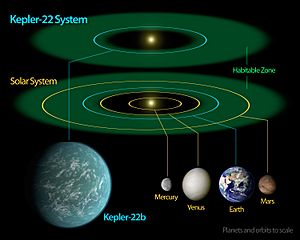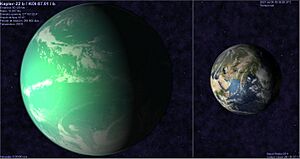Kepler-22b facts for kids

Artist's impression of the Kepler-22 system and its planet (sizes to scale) compared to the planets of the inner Solar System with their respective habitable zones.
|
|
| Discovery | |
|---|---|
| Discovered by | Kepler Science Team |
| Discovery site | Kepler telescope |
| Discovery date | 5 December 2011 (announced) |
|
Detection method
|
Transit |
| Orbital characteristics | |
| 0.849 ± 0.018 AU (127,000,000 ± 2,700,000 km) | |
| Eccentricity | 0 |
| 289.862 ± 0.02 d | |
| Inclination | 89.764 +0.042−0.025 |
| Star | Kepler-22 (KOI-087) |
| Physical characteristics | |
|
Mean radius
|
2.4 +0.19−0.07 R⊕ |
| Mass | <52.8 M⊕ |
| Temperature | 262 K (−11 °C; 12 °F) |
Kepler-22b is a fascinating exoplanet that orbits a star similar to our Sun. It's located about 600 light-years away from Earth. You can find it in the constellation called Cygnus.
Scientists from NASA's Kepler Space Telescope discovered Kepler-22b in December 2011. It was a very exciting find! This planet was the first one known to orbit within the "habitable zone" of a Sun-like star. The habitable zone is the perfect distance from a star where liquid water could exist on a planet's surface. This is important because liquid water is key for life as we know it.
Kepler-22b is much larger than Earth. Its radius is about 2.4 times bigger. We don't know exactly what it's made of, but scientists think it might be a "water world." This means it could have a lot of water, perhaps even a deep ocean.
Contents
About Kepler-22b
Kepler-22b is an extrasolar planet (a planet outside our Solar System) that orbits the star Kepler-22. It's quite far away, about 620 light-years from Earth. This amazing planet was found by the Kepler Space Telescope.
Size, Mass, and Temperature
Kepler-22b is much bigger than Earth. Its radius is about 2.4 times larger. We don't know its exact mass or what its surface is made of. However, scientists believe it's not made of the same rocky materials as Earth.
Instead, Kepler-22b might be an 'ocean-like' planet, sometimes called a "water world." Imagine a planet mostly covered in water! Scientists think it might have a liquid or gaseous outer layer. One of the scientists, Natalie Batalha, even wondered if life could exist in such an ocean if the planet has a small rocky core. This idea makes scientists interested in searching for extraterrestrial life there.
If Kepler-22b didn't have an atmosphere, its temperature would be around -11°C (12°F). For comparison, Earth's temperature without an atmosphere would be about -18°C (-0.4°F).
Its Home Star: Kepler-22
Kepler-22b orbits a star named Kepler-22. This star is a bit smaller and less massive than our Sun. It's about 3% less massive and 2% smaller in size.
Kepler-22's surface temperature is about 5,518 K (5,245°C or 9,473°F). Our Sun is a bit hotter, at 5,778 K (5,505°C or 9,941°F). The star Kepler-22 is also a bit younger than our Sun, at about 4 billion years old. Our Sun is about 4.6 billion years old.
Kepler-22 is too dim to see with your bare eyes. You would need a telescope to spot it.
Kepler-22b's Orbit
Kepler-22b takes about 290 days to orbit its star. This is similar to how long Earth takes to orbit the Sun (365 days). From Earth, we can see Kepler-22b pass in front of its star. This event is called a transit.
Scientists are still working to learn more about its orbit. They use different methods, like looking at how the star wobbles slightly. This helps them understand more about the planet's path around its star.
Could Life Exist on Kepler-22b?

Kepler-22b is located in the "habitable zone" of its star. This means it's not too hot and not too cold for liquid water to exist. The planet is about 15% closer to its star than Earth is to the Sun. However, its star, Kepler-22, is also about 25% dimmer than our Sun. This combination means the planet could have a moderate temperature.
If Kepler-22b has an atmosphere like Earth's, its average surface temperature could be around 22°C (72°F). This is a very comfortable temperature! However, if its atmosphere is very thick, like on Venus, it could be extremely hot, around 460°C (860°F).
Scientists believe there's a high chance (over 95%) that Kepler-22b is in a good spot for life. This is based on how Venus and Mars might have supported life in the past.
Discovery and Observations
The first time scientists saw Kepler-22b pass in front of its star was on May 12, 2009. This was only three days after the Kepler telescope started its scientific work! The third transit was seen on December 15, 2010.
Other telescopes, like the Spitzer Space Telescope, also helped confirm the planet's existence. Finally, on December 5, 2011, the discovery of Kepler-22b was officially announced.
Kepler-22b in Pop Culture
Kepler-22b has appeared in many books and games!
- It's a key part of the story in the 2012 science fiction novel Kepler 22b by Bangladeshi author Muhammad Zafar Iqbal.
- It's used as a map in the video games Age of Civilizations (2014) and Age of History II (2017).
- The 2019 children's science fiction book series Kepler by Sri Lankan author Binendra uses it as a setting.
- It's the home planet of a character named Andan in an online game called an alternate reality game (A.R.G.) from 2019.
- The 2020 U.S. TV series Raised by Wolves is set on Kepler-22b.
- There's a song titled "Kepler-22b" on the album Omnium Gatherum by the band King Gizzard & the Lizard Wizard.
- It was even mentioned in an episode of Star Trek: Strange New Worlds called "Spock Amok."
Images for kids
See also
 In Spanish: Kepler-22b para niños
In Spanish: Kepler-22b para niños





